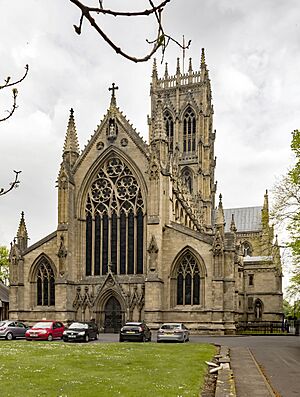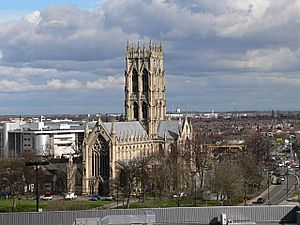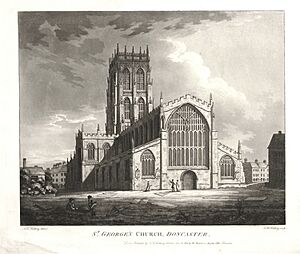Doncaster Minster facts for kids
Quick facts for kids Doncaster Minster |
|
|---|---|
| The Minster and Parish Church of St George, Doncaster | |

St George's Minster, Doncaster
|
|
| 53°31′32.88″N 1°8′7.44″W / 53.5258000°N 1.1354000°W | |
| OS grid reference | SE 5742 0356 |
| Location | 9 Church Street, Doncaster, South Yorkshire DN1 1RD |
| Country | England |
| Denomination | Church of England |
| Churchmanship | Broad Church |
| Website | doncasterminster.org |
| History | |
| Dedication | St George |
| Consecrated | 14 October 1858 |
| Architecture | |
| Functional status | Active |
| Heritage designation | Grade I listed |
| Designated | 12 June 1950 |
| Architect(s) | George Gilbert Scott |
| Architectural type | Gothic Revival |
| Style | Gothic Revival |
| Groundbreaking | 1854 |
| Completed | 1858 |
| Construction cost | £48,000 |
| Specifications | |
| Length | 168.5 feet (51.4 m) |
| Width | 92 feet (28 m) |
| Height | 160 feet (49 m) |
| Bells | 8 |
| Administration | |
| Parish | St George Doncaster |
| Deanery | Doncaster |
| Archdeaconry | Doncaster |
| Diocese | Diocese of Sheffield |
| Province | Province of York |
Doncaster Minster, also known as the Minster and Parish Church of St George, is a special church in Doncaster, South Yorkshire, England. It is part of the Church of England. This beautiful building is considered very important and is a Grade I listed building. It was designed by a famous architect named George Gilbert Scott.
The church was built between 1854 and 1858. It replaced an older church that was destroyed by a big fire. Today, it is still a busy place of worship. It has a famous organ built by Johann Friedrich Schulze, a set of eight bells, and a well-known clock made by Dent. Doncaster Minster is one of only two parish churches in South Yorkshire that has "minster" status. The other is in Rotherham.
Contents
History of the Minster
The first church on this spot was built in the 12th century. It was a Norman style building. Sadly, this old church burned down on the last day of February in 1853. A medieval library, which was located above the south porch, was also lost in the fire.
After the fire, a new church was needed. The famous architect Sir George Gilbert Scott designed the current building in 1853. Construction started in 1854 and finished in 1858. The cost to build it was about £43,126. The Archbishop of York officially opened the new church on October 14, 1858.
The Minster Today
Doncaster Minster is one of the most important buildings in Doncaster. Its Grade I listing shows how special it is. Sir John Betjeman once called it "Victorian Gothic at its very best." This means he thought it was a perfect example of the Victorian Gothic style.
The church was given "minster" status on June 17, 2004. This means it is recognized as a very important church. It is still an active place of worship with regular services. It is also used for important town events, concerts, and other celebrations. The Minster is part of the Major Churches Network. This group includes many of England's largest and most important parish churches.
Inside the Minster, you can find some amazing things. There is a clock made by Dent. This company also designed the famous clock at the Palace of Westminster, which is known as Big Ben. The Minster also has a spectacular organ with five keyboards. It was built by the famous German organ builder Edmund Schulze (1824–1877).
The Minster has eight bells. The heaviest bell weighs about 29 long tons.
Organs and Organists
The Minster is famous for its incredible organ.
Organists and Choirmasters
Many talented musicians have served as organists and choirmasters at Doncaster Minster over the years. Some of them include:
- Edward Miller (from 1756)
- Jeremiah Rogers (from 1835)
- Robert M. Rogers (from 1879)
- Harold Aubie Bennett (from 1923)
- Owen Le Patourel Franklin (from 1946)
- Magnus Black (from 1957)
- Darren Williams (from 2009)
The 1862 Schulze Organ
A New Organ from the Ashes
The old church had a very good organ from 1739–40. People said it was one of the best in England. The organist, Jeremiah Rogers, even paid for many improvements himself. This organ was destroyed when the church burned down in 1853.
When the new church was being built, Jeremiah Rogers wanted the best organ in the world. He traveled around Europe to see famous organs. He often went with his friend E. J. Hopkins, who was an organist too.
J. F. Schulze and Sons
Johann Friedrich Schulze was a German organ builder. He started making organs in 1825. In 1851, he showed an organ at the Great Exhibition in London. This organ had new features that interested many people.
E. J. Hopkins was very impressed by Schulze's organs. He visited a Schulze organ in Bremen Cathedral in 1852. He said the sound was "exceedingly solemn, grand or soothing." He felt a "great enchantment" when he played it.
Because of this, Schulze was chosen to build the new organ for Doncaster Minster in 1857. Johann Friedrich Schulze died in 1858. His son, Heinrich Edmund Schulze, took over the business. Edmund convinced Jeremiah Rogers to make the organ even bigger. It became a five-keyboard instrument with 94 different sounds. This made it one of the largest church organs in England at the time.
In 1860, the parts for the organ arrived from Germany. Edmund Schulze and his team worked for two years inside the church to build it. The new organ was officially opened on September 24, 1862. The Doncaster organ was the biggest one the Schulze company ever built.
Special Features of the Schulze Organ
The Doncaster Schulze organ had many new and clever ideas. It had huge pedal soundboards. This allowed each pedal sound to be played at two different pitches. This made the pedal section very rich and full.
The organ also had special "free reeds." These are unique pipes that create a very distinct sound. The Doncaster organ has the only known 32-foot free reed in England.
Another new idea was the wooden 16-foot Violone pipe. This pipe was designed to make the pedal sounds clearer. Other special features included unique flute pipes made from wood. The most famous part of the Doncaster Schulze organ is its powerful "Great Flue Chorus." This section has many pipes that create a very strong and full sound.
Later Work on the Organ
Over the years, some changes and updates have been made to the organ.
- In 1910, a company called Norman & Beard added new parts to the organ. They added eight new sounds.
- In 1935, J W Walker & Sons Ltd. installed a new control system. This made the organ easier to play.
- In 1958, they cleaned the organ and replaced some old parts.
- In 1999, a new console (the part with the keyboards and stops) was installed.
Why the Organ is Important
The organ at Doncaster Minster is considered a masterpiece by Edmund Schulze. It is one of the largest organs in Europe. Many experts believe this single instrument changed how organs were built in Britain. Doncaster became a very important place for musicians and organ builders to visit.
T.C. Lewis, a Victorian architect, was very impressed by the organ. He said, "...anything finer it is, I believe, impossible to imagine...it is by far the grandest instrument I have ever heard."
Dr. Nicholas Thistlethwaite, an expert on organs, said that the Doncaster organ was one of the two most important organs built in England in the second half of the 19th century. Its historical importance is that it was so good, it didn't need constant rebuilding like other organs of its time.
Some music has even been written especially for the Doncaster Schulze organ. This includes Francis Jackson's Fourth Organ Sonata.
Gallery
-
The font where baptisms take place.
-
The chancel, the area around the altar.
-
The nave, the main part of the church where people sit.
-
The pulpit, where sermons are given.
See also
- Grade I listed buildings in South Yorkshire
- Listed buildings in Doncaster (Town Ward)
- List of new churches by George Gilbert Scott in Northern England







